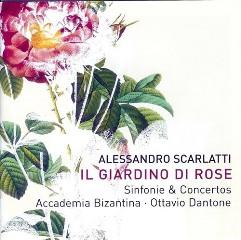Scarlatti - Il Giardino di Rose (Sinfonie & Concertos) [2004]
Scarlatti - Il Giardino di Rose (Sinfonie & Concertos) [2004]

01] Sinfonia 'Agar et Ismaele Esitiati' - Grave - Presto - Largo - Presto - Presto 02] Concerto III - I. Allegretto comodo 03] Concerto III - II. Andante con spirito 04] Introduttione 'San Filippo Neri' - [Allegro] - Adagio e staccato 05] Concerto VI - I. Allegro moderato 06] Concerto VI - II. Andante con espressione 07] Sinfonia 'Il Primo Omicidio' - I. Spiritoso - Adagio - Allegro 08] Concerto V - I. Allegro 09] Concerto V - II. [Presto] 10] Sinfonia 'L'Assunzione della Beata Vergine' - Largo - Presto -[Largo] - [Presto] - Allegro 11] Concerto IV - I. Andante 12] Concerto IV - II. Allegretto modeato 13] Sinfonia 'Il Trionfo della Vergine in Cielo - Presto - Allegro' 14] Concerto I - I. Allegro 15] Concerto I - II. Allegretto 16] Sinfonia 'Il Giardino Di Rose' - Adagio - Presto - Largo e piano - Allegro 17] Concerto II - I. Anadantino 18] Concerto II - II. Andante con moto Accademia Bizantina Ottavio Dantone – conductor
Here are Sinfonias from six of Alessandro Scarlatti's oratorios interspersed with six short harpsichord concertos that once were doubtfully attributed to the composer, though recent evidence now suggests that they are authentic. Scarlatti's debt to his close friend Archangelo Corelli (arguably the greatest influence on his instrumental writing) more or less informs these concertos, at times blatantly, such as in the Andante con espressione movement of Concerto VI. Unlike Corelli, who in comparison produced a relatively small body of work, Scarlatti's voluminous oeuvre generally lacked his colleague's consistent invention and originality. Themes rarely evolve beyond the predictable, genuine melodies are in short supply, and rhythmic structures too often rely strictly on repetition. Should this in any way deter you from acquiring this lovely program? Not in the least!
While not in the league of Corelli or a handful of some of his better-known contemporaries, Scarlatti borrowed from the best and often successfully recycled what he pilfered--and given the Accademia Bizantina's ravishing performances here, most Baroque enthusiasts will find plenty to enjoy. All of the concertos are in two movements featuring a typically orthodox opening fugue followed by another more progressive one that allows the soloist greater opportunity to improvise. The group's director and harpsichordist Ottavio Dantone (who also was responsible for reconstructing these concertos from often sketchy manuscripts) delivers impassioned, well-considered performances throughout, though his fierce bravura in the Andante con spirito of Concerto III and the contrasting elegance and panache with which he embellishes the Allegro moderato of Concerto IV best make a case for the composer's range and versatility.
Scarlatti especially excelled in oratorio and opera (he wrote hundreds), so as we might expect, the sinfonias are among the most inspired works on the program. The thrilling solo violin and cello passages, particularly in the outer movements of the Sinfonia of Il primo omicidio (The first murder), are quite impressive if not dramatically evocative of the seriousness of the crime in question. Equally fascinating is the sinfonia from L'Assunzione della Beata Vergine (The Assumption of the Blessed Virgin), the opening violin meandering amid fiercely erupting orchestral waves that eventually resolve into a humorous mimicking dialogue between the high and low strings.
Decca's sound is first-rate, with exceptional clarity and ensemble presence. Besides the erudite explanatory notes, Dantone also offers an equally informative discussion of the criteria used for each concerto's reconstruction as well as brief comments about the selected sinfonias. Recommended. ---John Greene, ClassicsToday.com
download: uploaded yandex 4shared mediafire solidfiles mega zalivalka filecloudio anonfiles oboom
Last Updated (Wednesday, 23 April 2014 21:02)








